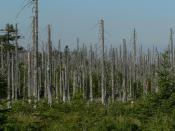Acid rain is caused when rain, fog, or snow passes through a layer of pollution. Acid rain is just a common term meaning acid deposition. Acid deposition is divided into two types, wet and dry. Wet acid deposition includes rain, fog, and snow. The potency of the acid rain depends on how acidic the water is to start and the chemistry and buffering capacity of the soil. Dry acid deposition includes acidic gases and particles. Acid rain occurs when sulfur oxides (SO2) and nitrogen oxides (NOx) react with water, oxygen and other chemicals in the atmosphere. Two-thirds of the sulfur oxides come from electric power generation. Nitrogen oxides are formed when any fossil fuel is burned. Bioavailability occurs when nutrients needed for plants and animals are dissolved into water for the fish to be able to use. When acid rain falls into a stream or a lake, it lowers the pH from the normal level to an acidic level.
Some necessary nutrients can only dissolve in a specific level of pH. If the pH is lower, certain poisonous substances can dissolve into the water and kill the living organisms.
The amount of hydrogen ions (H+) in a solution is called the pH. pH is based on a scale from zero to fourteen; zero being the most acidic and fourteen being the most basic (alkaline). On the pH scale, distilled water is pH 7, which is also neutral. On the scale, natural rainfall would be approximately 5.5 to 5.7. If a substance has a pH of 3, then that substance is 10 times more acidic than if something had a pH of 4. Limestone can actually be added to acidic lakes, with a pH under 8, to reduce the level of toxicity.
Some of the natural sources for a lower...

![Copper mining and sulfuric acid plant, Copperhill], Tenn. (LOC)](https://s.writework.com/uploads/3/32663/copper-mining-and-sulfuric-acid-plant-copperhill-tenn-loc-thumb.jpg)
